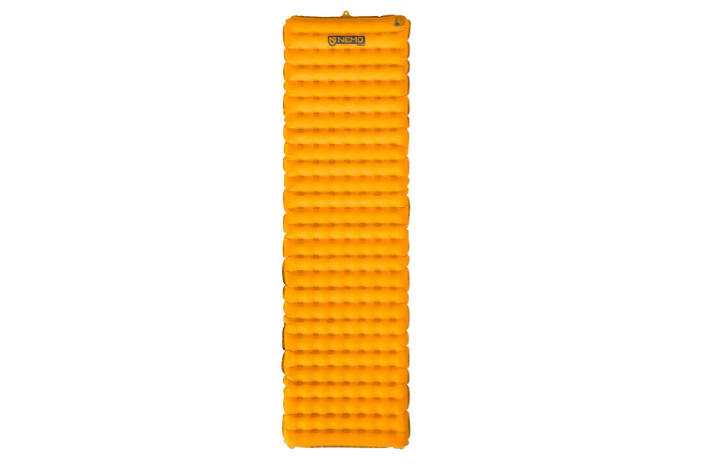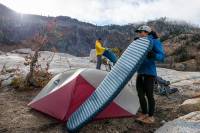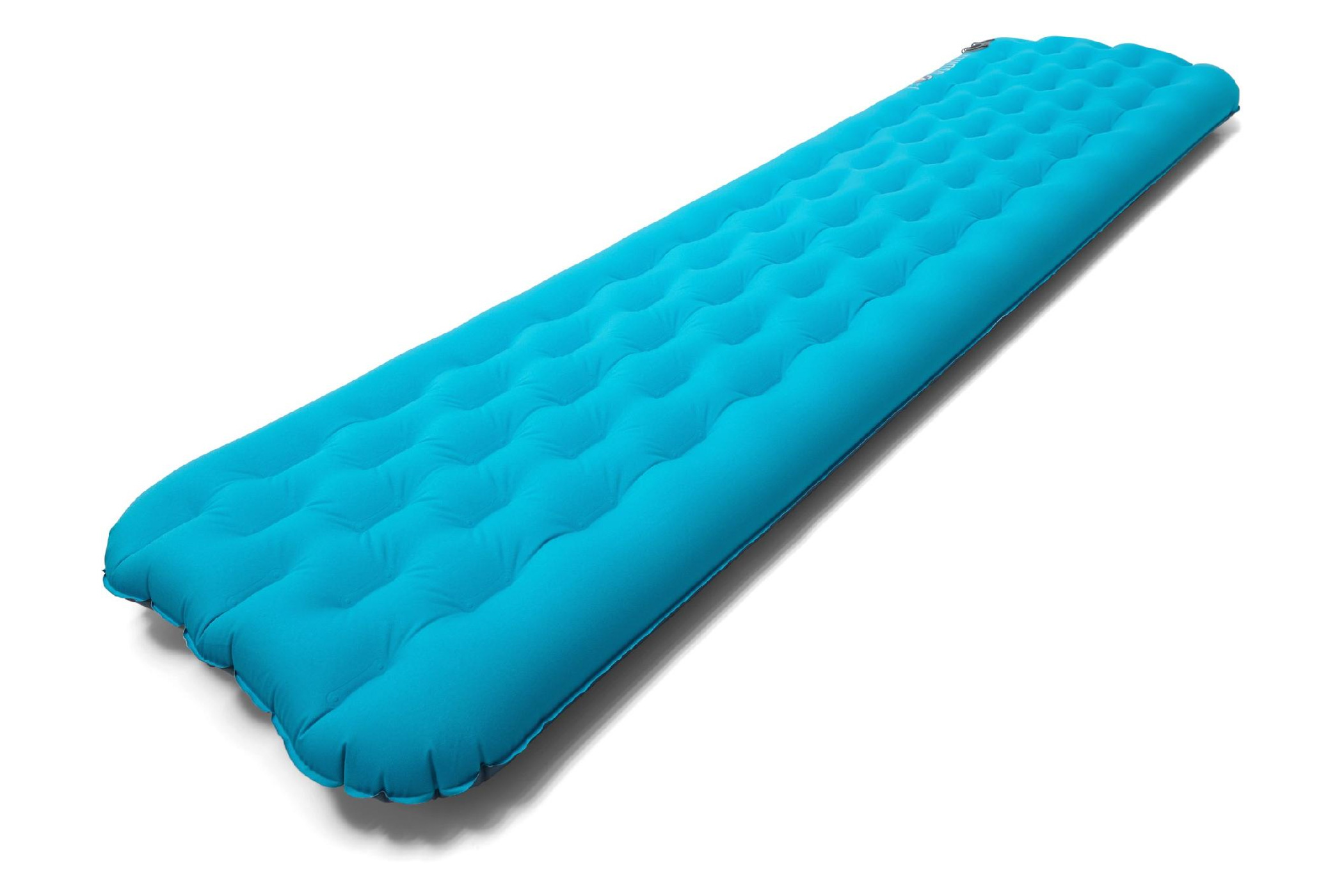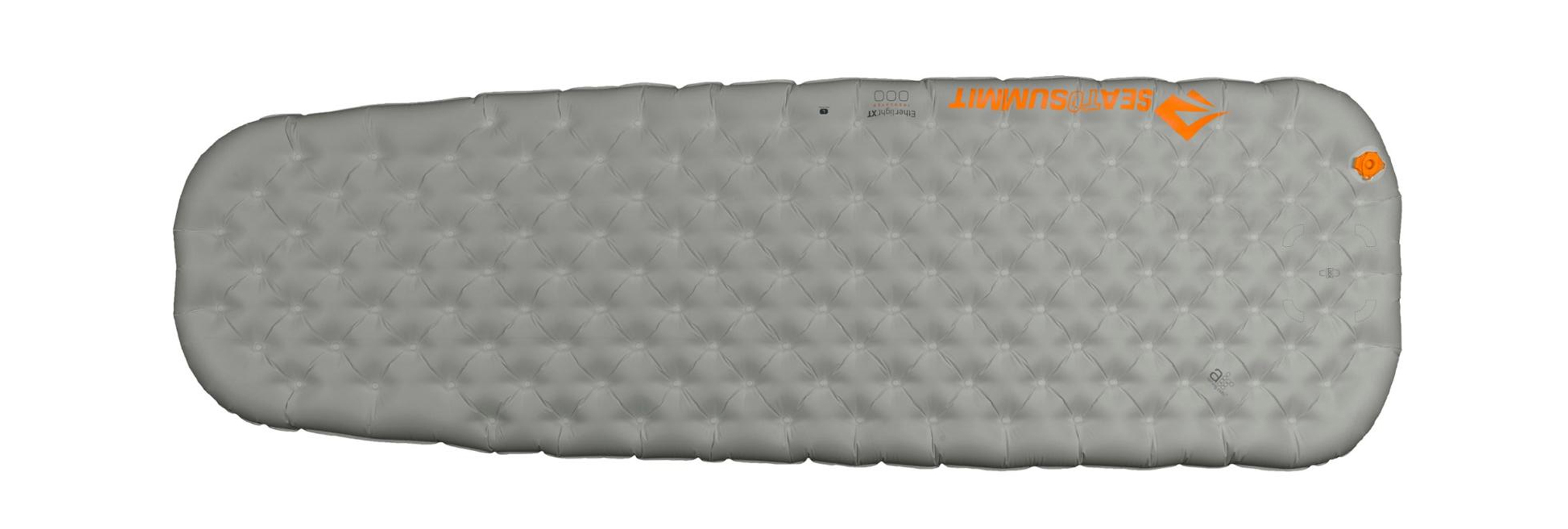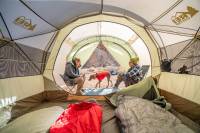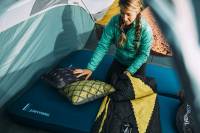The Best Backpacking Sleeping Pads of 2021
Our trail-loving experts found the best backpacking sleeping pads for every use and budget. From side-sleeping comfort to ultralight packability, we’ve got you covered.
The biggest concern with backpacking sleeping pads is finding the right balance between comfort and weight. And this balance depends largely on the individual. Ounce-counters may prefer the lightest pad possible, even if it means forgoing some comfort.
However, other backpackers may prefer to give up weight in other areas so they can happily carry a larger, more comfortable sleeping pad.
There are benefits to both approaches, but it’s worth knowing what matters most to you before continuing. We’ve broken down the best backpacking sleeping pads into categories to help you find the right sleeping pad for you.
Scroll through to see all of our recommended buys or jump to the category you’re looking for. At the end of our list, be sure to check out our comprehensive buyer’s guide and use our comparison chart to help finalize your decision.
- Best Overall
- Best Budget
- Warmest Sleeping Pad
- Most Comfortable
- Best Ultralight
- Most Indestructible
- Best for Side Sleepers
- Best of the Rest
The Best Backpacking Sleeping Pads of 2022
Best Overall Backpacking Sleeping Pad: Therm-a-Rest NeoAir XLite
The classic pick for thru-hikers or backcountry adventurers who need ultralight simplicity in a durable package, the NeoAir XLite ($200) has firmly established itself in the backpacking community. One of our testers used this pad alone for all three thru-hikes of the Triple Crown (AT, PCT, and CDT), and while most accrued their fair share of patches along the way, they kept him warm and cozy through all sorts of terrain and climates.
The XLite uses a unique technology called a Triangular Core Matrix, which stacks two layers of triangular baffles to create a super stable surface while trapping as much heat as possible. This, combined with a reflective thermal layer, keeps the pad at a featherlight 12 ounces, while still boasting an R-Value of 4.2. This makes it, aside from Therm-a-Rest’s Uberlite with half the R-value, the lightest pad on this list.

The obvious question when you see such a light pad is, “how long will it survive”? While it’s not as durable as some of the heavier denier pads we cover here, we can say from personal experience that if you take care of it, it’ll fend off punctures and slow leaks over months of torture.
This pad packs up tiny and disappears in your pack, yet offers superior comfort and warmth. This pad is perfect for light, or ultralight, backpacking kits in pretty much any temperature you may encounter on a three-season thru-hike.
The WingLock valve used to inflate/deflate the pad is brilliant. A larger opening than previous iterations allows it to inflate fast, and a one-way flap means you can pause between breaths without having air escape. Opening the valve and twisting the wings deflates the pad swiftly. The worst part of each morning.
Negatives? It’s a loud one, particularly when you first get it. Hiking partners will know if you’re a restless sleeper, but it does quiet down fine after breaking it in.
In short, the NeoAir XLite is one of the best lightweight, durable, and streamlined pads you can buy for long treks across the country, or sporadic adventures into the mountains where weight and warmth are paramount.
Specs:
- Weight: 12 oz.
- R-value: 4.2
- Thickness: 2.5″
Pros:
- Super light for its high R-value
- Comfortable and sturdy
- Durable enough for 2,000+ mile thru-hikes.
Cons:
- Quite loud and crinkly until it’s broken in
Check Price at REI Check Price at Amazon
Best Budget Sleeping Pad: Klymit Static V
The Klymit Static V ($59) is an incredible value. For less than 60 bucks, you can get a super-packable and quite comfortable backpacking pad. At a little over a pound, it’s not ultralight, but it’s certainly on the light end of the spectrum.
It packs down easily and only takes a few breaths to inflate. We’ve had one in testing that wore out after 6 months of hard use and stopped holding air, but we’ve had another in testing for more than 18 months with no durability concerns.
If you sleep cold or are camping during the fall or winter, you may want to consider a pad with a higher warmth rating. The Static also comes in a long and wide version if you need a little more wiggle room. They weigh and cost a bit more, but they offer up more comfort and still clock in under $100.
Read our full review of the Klymit Static V.
Specs:
- Weight: 18.6 oz.
- R-value: 1.3
- Thickness: 2.5″
Pros:
- Packs small
- Affordable
Cons:
- Not insulated
- Long-term durability concerns
Check Price at BackcountryCheck Price at Amazon
Warmest Sleeping Pad: Exped Ultra 7R
Exped’s Ultra 7R ($230) is a super cool pad. Here’s the bottom line: it’s made with a layer of down insulation that boosts the R-value to an absurd 7.1. All while tipping the scales at a relatively scant 22.9 ounces, and packing down small enough for lightweight backpacking or mountaineering. It’s rad. For the alpine athlete needing maximum warmth in sub-zero conditions, or those intrepid winter thru-hikers, the Exped Ultra 7R could be a game changer.
Xped employed what they call Downmat Technology in this pad, including a layer of premium 700-fill down coupled with a 9 cm air cushion, offering one of the coziest, warmest nights of sleep our testers have had on a backpacking trip. It feels like they hit that massive, plush air mattress you use for sleepovers at your friend’s house with a shrink-ray gun and made it packable.

Notable features of the Ultra include a 20 denier ripstop face fabric that fends off poky sticks or rocks, an included “Schnozzel” pump bag (which we feel worked better than some other designs out there), and an “in” and “out” valve for simple inflating and deflating.
While there are lighter pads out there with R-values that come close to the Ultra’s, this is one of the thicker ones on the market, and therefore more comfortable. This also makes it a great pad for side sleepers.
We could come up with almost no negatives for this plush pad. But if we had to pick one, we found it somewhat difficult to top off the air in the pad with our mouth after doing the bulk of the work with the Schnozzel, as the valve lays quite flush with the pad. A quick word of caution on this — it’s important to use the Schnozzel to inflate it as often as possible, as moisture buildup from your breath could damage the down fill inside over time.
While it is on the heavier/bulky side, for the insulation and overall comfort you are getting, we feel they’ve kept it very light and manageable.
The Ultra 7R is an incredible and surprisingly affordable piece of engineering. We have no hesitation recommending it to any dedicated adventurer who needs a reliable, mega-warm pad for gnarly conditions in the mountains.
Specs:
- Weight: 22.9
- R-value: 7.1
- Thickness: 3.5″
Pros:
- Super high R-value at a pretty low weight
- Down layer adds superior insulation
- Durable fabric protects against punctures
Cons:
- On the bulky side
Check Price at REICheck Price at BlackOvis
Most Comfortable Sleeping Pad: NEMO Tensor
The NEMO Tensor Sleeping Pad ($190-220) has always been wide, supportive, quiet, and relatively warm. The original Tensor was somewhere between good and great. It’s been upgraded for 2022, and the results are top-notch.
The pad’s improvements come from the inside out. NEMO redesigned its Spaceframe — what the brand calls the structural baffles inside the pad that give it support and stability — to make both the insulated and uninsulated pads warmer.
The new baffle design still has individual tack points that prevent the pad from feeling like a raft underneath you, and the insulation is still woven between the baffles in a way that keeps it quiet. There’s no pad squeaking or crinkling while rolling around.
The pad comes with the NEMO Vortex Pump Sack, which inflated all sizes of the pad quickly and efficiently without filling the pad with moisture from my breath.
It’s available in mummy and rectangular shapes, two lengths, and as both insulated and uninsulated options. Though this pad is light and compact enough to use for backpacking, it’s plenty comfortable and durable for car camping too.
Check out our full review for more info on this cozy pad.
Specs:
- Weight: 13.8-15 oz.
- R-value: 4.2 (insulated), 2.5 (uninsulated)
- Thickness: 3 in.
Pros:
- Very comfortable
- Remains quiet when rolling around
- Stable yet plush
Cons:
- Not the warmest
Check Price at REICheck Price at Amazon
Best Ultralight Backpacking Sleeping Pad: Therm-a-Rest NeoAir Uberlite
The most impressive thing about the NeoAir Uberlite ($219-250) is its weight — or lack thereof. At just 8.8 ounces, it certainly won’t weigh you down. And because it packs down to the size of a soda can, you’ll have more room in your pack for other gear and snacks.
But what really won us over is its comfort level. We were pleasantly surprised to find it felt great and wasn’t noisy when we shifted positions during the night.
As one tester noted, “It was just as comfortable as other air mattresses of the same thickness. I could sleep on my side at my preferred air pressure without shoulder or hip pain.
“I flip sides while sleeping, and the UberLite was worlds quieter than the XLite, something tentmates and campsite neighbors will appreciate. I’ve had neighboring campers get up and move in the middle of the night because of the crackling of my XLite.”
Since 2020, Therm-a-Rest backpacking sleeping pads have featured the WingLock Valve. The wings toggle for one-way inflation, making it far easier to blow up. It’s the same easy-to-use Therm-a-Rest valves we’ve reliably used for years, except greatly improved.
It’s also available in a large version, which retails for $250 and weighs in at 12 ounces.
Read our full review for the NeoAir Uberlite.
Specs:
- Weight: 8.8 oz.
- R-value: 2
- Thickness: 2.5″
Pros:
- Extremely light
- Packs down to the size of a soda can
Cons:
- Not as warm as insulated pads
Check Price at REICheck Price at Amazon
Most Indestructible: NEMO Switchback
It’s hard to add even more innovation to the simple design and concept of an accordion-style foam pad, but the NEMO Switchback ($33-55) continues to impress backpackers and campers with each new design and update. Their latest iteration offers even greater plushness via taller nodes in a smaller pack size, for a cozy, warm pad that will hold up to the wear and tear of weekend use, or a months-long thru-hike. Plus, at $55, it’s a nice break for your wallet.
For years the Therm-a-Rest Z Lite has been the industry’s foam pad standard, without much competition. Now, with the Switchback making a name for itself in the backpacking world, it’s not the only slab of foam seen strapped to hiker’s packs on trail.
Though it’s 0.5 ounces heavier than the Z Lite, and holds the same R-value of 2, it’s a tad bit thicker and we feel like it offers just a little more cushion and comfort. It’s definitely one of the best foam pads we’ve slept on.

A metalized thermal reflective film bounces heat back to your body, while dual-density Axiotomic foam provides a soft layer of comfort, paired with a tougher layer for support. This makes the pad a solid insulator on its own in milder temps, or a great way to add more comfort, protection, and warmth when paired with an inflatable pad on colder adventures.
While we haven’t had the chance to put it through a 2,000+ mile trek yet, it’s shown little wear and tear as we’ve tested it, and a plethora of online comments praise its durability and comfort over the length of a taxing thru-hike. We’d say you don’t have to worry about this falling apart any time soon.
As an ultralight standalone pad for fast and light missions, or another addition to your sleep system for freezing expeditions, the NEMO Switchback will have you in a deep, comfortable slumber every night.
Specs:
- Weight: 14.5 oz.
- R-value: 2.0
- Thickness: 0.9″
Pros:
- Dual-density foam offers plush comfort while still being supportive
- Taller nodes and smaller pack size than other models
- Indestructible
Cons:
- Not as comfortable as inflatable pads
- Bulky pack size
Check Price at REICheck Price at Backcountry
Best Sleeping Pad for Side Sleepers: Big Agnes Insulated Q-Core Deluxe
Are you looking for a sleeping pad that will keep you comfortable and warm even when you’re deep in the backcountry? It’s time you met the Q-Core ($170-250). With an R-value of 4.3, it delivers excellent insulation from the ground, keeping you cozy all night.
We also found this pad incredibly comfortable. The 3.5-inch thickness is enough to satisfy even the side sleepers among us, and the 20-inch width is just enough to keep most testers happy.
For added comfort, there are wide and XL versions available. Just remember that increasing the dimensions will add to the weight and packed size.
It’s not as quiet as foam-insulated camping pads, but we found the slight crinkle level acceptable. The dual valves made inflation easy, and once you get the hang of it, the inflation sack is helpful and breath-saving.
Specs:
- Weight: 1 lb. 9 oz.
- R-value: 4.3
- Thickness: 3.5″
Pros:
- Warm
- Extremely comfortable
Cons:
- Not the lightest available
Check Price at REICheck Price at Amazon
Best of the Rest
Sea to Summit Comfort Plus Insulated
Our editor has been testing this sleeping pad ($219-239) since it came out in 2015. And as of 2022, it’s still going strong, having never sprung a leak.
One of our favorite things about this pad is the double air chambers. This feature has proven to be integral in preventing tears and gives it a built-in redundancy. If one side pops (which it hasn’t in many, many camping trips for our tester), the other should still be good, keeping you off the cold ground.
The double chambers also allow you to create a custom firmness. You can inflate it by blowing, which is very easy to do and doesn’t take many breaths to fill.
You can also use the pump bag that comes integrated into the stuff sack. Either way, it’s fast and easy to fill this pad.

At 1 pound, 13.8 ounces, this pad is on the heavy side for backpacking, but we’re willing to carry a little extra weight for when temps drop low at night. The redundancy alone is worth a few extra ounces, and the pad works great for car camping too.
Although the 40-denier fabric isn’t the toughest possible, we’ve found it plenty strong in addition to being warm, packable, and comfortable. And if something does go awry, the pad comes with a repair kit. All in all, the Comfort Plus Insulated is a great backpacking and car camping sleeping pad.
Specs:
- Weight: 1 lb. 13.8 oz.
- R-value: 4
- Thickness: 2.5″
Pros:
- Dual air chambers provide redundancy and allow for custom firmness
- Packs down small
Cons:
- Expensive
- Not as light as other pads
Check Price at REICheck Price at Backcountry
NEMO Flyer
The NEMO Flyer ($120-140) combines the best of foam-core comfort with air bed packability. At 1 pound 6 ounces, it’s not the lightest option, but the added comfort is worth it if you don’t mind a few more ounces.
As our reviewer noted, “The NEMO Flyer is a lightweight, three-season pad that hits the sweet spot between an air pad and a self-inflating foam pad. The unique air-filled foam baffles create stable, cushioned thickness with more durability and resistance to bottoming than an air pad, with a slight weight and bulk penalty. But it’s lighter and packs smaller than a self-inflating pad.”
Read our full review for the NEMO Flyer.
Specs:
- Weight: 1 lb. 6 oz.
- R-value: 3.3
- Thickness: 2″
Pros:
- Foam durability and padding
- Plus air pad comfort
Cons:
- Heavier/bulkier than some other options
Check Price at REICheck Price at Amazon
Therm-a-Rest ProLite Plus
The Therm-a-Rest ProLite Plus ($110-140) is comfortable and warm without sacrificing much in the realm of price and packed size. Made from a mix of foam and air baffles, it offers an excellent warmth-to-weight ratio.
We gave it a couple of breaths to top it off and were immediately pleased with the comfort and insulation. It packs down smaller than a roll of paper towels and weighs a little over a pound.
With an R-value of 3.2, this could be a year-round sleeping pad for those who run warmer. For those who tend to get cold at night, you’ll most likely prefer something more insulated in winter.
It’s also available in a women’s-specific design.
Specs:
- Weight: 1 lb. 7 oz.
- R-value: 3.2
- Thickness: 1.5″
Pros:
- Warm
- Comfortable
Cons:
- Not as light as some pads
Check Price at REICheck Price at Amazon
Sea to Summit Ether Light XT Insulated
This insulated sleeping pad ($179-189) packs down small and has some extra features that make it stand out.
First off, we liked the integrated pump bag that’s built into the stuff sack (called the Airstream pump). Basically, you lightly blow into the bag and then squeeze the air into the pad. It seems weird at first, but it’s much less energy-intensive than directly blowing up the pad.

This pad also has a “pillow lock” that helps certain Sea to Summit pillows stay in place. Its sticky felt grabs onto the pillow to keep it from moving around while you sleep. If you already have an Aeros Pillow, this could be great. If not, it might not do you any good.
These features aside, the Ether Light XT provides extra insulation for cold nights and is light enough to easily take backpacking. It’s not the cheapest out there, but this is an excellent choice if extra insulation and less weight are important to you.
Specs:
- Weight: 15 oz.
- R-value: 3.8
- Thickness: 4″
Pros
- Warm
- Light
- Packs small
Cons
- Expensive
Check Price at REICheck Price at Backcountry
Therm-a-Rest Z Lite Sol
There’s a reason closed-cell foam is a cult classic. It’s light, it’s warm, and it’s virtually indestructible. It’s no surprise that you regularly see it listed among thru-hikers’ favorite pieces of gear.
The crazy popular Z Lite ($55) has been the leader in ultralight foam pads for a long time and still stands as a good choice today. The aluminized surface (the silver side) reflects heat back toward your body and provides extra warmth at night, while the egg-carton pattern increases comfort and insulation.
Even if you don’t plan to use this as your sole sleeping pad, it’s a great addition to whatever else you choose to use on top. It provides unmatched durability and extra insulation, which are integral factors for getting a good night’s rest at camp.
Specs:
- Weight: 14 oz.
- R-value: 2.0
- Thickness: 0.75″
Pros:
- Super durable
- Multifunctional
- Light
Cons:
- Not as comfortable as other inflatable pads
- Bulky pack size
Backpacking Sleeping Pad Comparison Chart
| Backpacking Sleeping Pad | Price | Weight | R-value | Thickness |
|
Therm-a-Rest NeoAir XLite |
$200 | 12 oz. | 4.5 | 2.5″ |
| Klymit Static V | $52 | 18.6 oz. | 1.3 | 2.5″ |
|
Xped Ultra 7R |
$230 | 22.9 oz. | 7.1 | 3.5″ |
| NEMO Tensor | $190-220 | 13.8-15 oz. | 4.2 (insulated), 2.5 (uninsulated) | 3″ |
| Therm-a-Rest NeoAir Uberlite | $190-250 | 8.8 oz. | 2 | 2.5″ |
|
NEMO Switchback |
$55 | 14.5 oz. | 2.0 | 0.9″ |
| Big Agnes Insulated Q-Core Deluxe | $170-250 | 1 lb. 9 oz. | 4.3 | 3.5″ |
| Sea to Summit Comfort Plus Insulated | $219-239 | 1 lb. 13.8 oz. | 4 | 2.5″ |
| NEMO Flyer | $120-140 | 1 lb. 6 oz. | 3.3 | 2″ |
| Therm-a-Rest ProLite Plus | $110-140 | 1 lb. 7 oz. | 3.2 | 1.5″ |
| Sea to Summit Ether Light XT Insulated | $179-209 | 15 oz. | 3.8 | 4″ |
| Therm-a-Rest Z Lite Sol | $55 | 14 oz. | 2.6 | 0.75″ |
Why You Should Trust Us

Buyer’s Guide: The Best Backpacking Sleeping Pads
A restful night’s sleep sets you up for success on a full day of backpacking adventures. In the past, people rightfully assumed sleeping on a pad on the ground could simply never match the comfort of a real bed.
However, in recent years, sleeping pads have improved significantly. Now, with advancements in cell design and baffling, many high-quality sleeping pads offer exceptional warmth and comfort.
While comfort standards have increased, packed size and weight have also dropped, and the resulting pads are light, easy to use, and wonderful to sleep on.
Because there are so many great pads on the market, it can be difficult to make a selection. In this guide, we break down some of the most important considerations for purchasing the perfect sleeping pad.
From weight and thickness to durability and price, we hope to answer all of your sleeping pad-related questions in this buyer’s guide.
Types of Sleeping Pads: Foam, Self-Inflating, and Air Pads

There are three types of backpacking sleeping pads: air pads, foam pads, and self-inflating pads. Each category has its own list of pros and cons, and it’s important to understand the differences between them.
Air Pads
Air pads are the lightest and most compact type of sleeping pad. When not in use, these pads are deflated and able to pack down into a small stuff sack about the size of a water bottle. Because most of their insulation comes trapped in air, they can become quite thick without excess weight or bulk.
Compared to other categories, air pads are the most vulnerable to punctures and air valve issues. Usually, punctures are fixable with the proper supplies, but some people stay away from air pads due to the puncture risk.
Most pads come with their own repair kits for punctures or tears, but our testers have had good luck with trusty Tenacious Tape in a pinch, or even super glue for fixing issues around the valve.
Self-Inflating Pads
Self-Inflating pads have been around for many decades. Most pads in this category combine inflation with open-cell foam to decrease puncture risk and increase durability.
However, self-inflating pads do not pack down as small as air pads, and they tend to be a bit heavier. If these pads do puncture or deflate, you’ll still have some padding between you and the ground, but it won’t be a comfortable night’s sleep.
Foam Pads

Closed-cell foam pads are the original backpacking sleep system technology. Although these tend to be the least comfortable pad style, they are extremely reliable and can last for decades if treated with care.
On a foam pad, you can sleep soundly without worrying about punctures. Usually, foam pads fold or roll to pack away, but they take up far more space in your pack than other types of pads and often have to be strapped to the outside.
Weight
For backpacking, the goal is always to minimize the total weight of your pack. These days, thick and comfortable pads that are also lightweight offer an ideal solution to backpackers.
Some single-person pads are as light as half a pound, while heftier options may weigh 2 full pounds. For a good balance between weight and durability, consider a pad that weighs around 14-18 ounces.
Thickness

On uneven or rocky ground, a thin pad will feel only slightly better than lying on the bare earth. As a general rule, thicker pads are more comfortable. However, thickness does add weight and bulk, so we suggest you aim to find a happy medium.
If you are a back sleeper, your weight will be a bit more evenly distributed and you may be able to get by with a thinner pad. Side sleepers tend to prefer thicker pads, such as the Big Agnes Q-Core Deluxe.
Any inflatable pad over 3.5 inches thick will be on the more plush side, whereas most foam pads are less than 1 inch thick.
Comfort
Generally, pads made for backpacking will be less plush than pads made for car-based camping. Because backpackers aim to minimize weight, pure comfort is not the priority.
Still, many modern pads offer a generous combination of insulation, padding, and sleeping area all in a lightweight package. For some backpackers, a bit of extra weight is a small price to pay for added comfort.
R-Value Explained

The R-value of a pad describes the amount of insulation between the user and the ground. Insulation prevents your body heat from escaping into the earth below. Without a well-insulated pad, sleeping on the ground is very chilly, even when the air temperature is reasonably warm.
In warmer conditions, a sleeping pad with an R-value of less than 3 should be sufficient. However, if you plan to backpack in the shoulder seasons, you’ll be better off with a higher rating (between 3 and 5). For winter camping or mountaineering, an R-value of at least 5, (like the Xped Ultra 7R) is the way to go.
Sleeping Pad Dimensions
Sleeping pads typically come in various sizes, and users can choose the option that best suits their body and preferences. Common sizes include regular, which is usually around 6 feet long, and large, which tends to be closer to 80 inches. Pad width also varies, but anywhere between 18 and 26 inches is fairly standard.
Most backpacking pads are semi-rectangular in shape, and some taper down and become more narrow toward the feet. Two-person sleeping pads are also available, but they’re quite cumbersome and generally not ideal for backpacking.
Packed Size

A pad’s packed size depends on construction, materials, and the amount of insulation. Air pads with minimal additional built-in insulation tend to pack down smaller than all other types of pads. Most air pads fit easily into a backpacking pack — some are no larger than a football.
Packed size can be an issue for foam and self-inflating pads. Once fully rolled, these pads can be quite cumbersome, and they often have to be carried on the outside of the pack.
Inflation and Deflation
While foam pads do not require inflation to use, all other pad types are built with an integrated air valve. Historically, valves have been the weak point of sleeping pads, and they can be difficult to replace once broken.
But now, high-quality backpacking pads come with reliable valves that are airtight and offer quick and easy inflation and deflation.
Most air pads have flat valves, which include an internal flap that prevents air from escaping in between inflation breaths. These valves are simple and durable, and most pads with flat valves can be inflated with somewhere between 10 and 25 breaths.
Self-inflating pads are designed to fill up on their own once the valve is open, but they usually need some regular inflation breaths to fully pump up and become firm.
Durability and Care

With proper maintenance, a good backpacking pad can last for many years with regular use. Foam pads can take lots of abuse and last forever, but inflatable pads are fragile and must be handled with care.
Punctures are the main threat to air pads. As with all outdoor gear, abrasion resistance and fabric thickness are measured with a denier rating. Thick fabric is more resistant to punctures. Air pad denier ratings vary widely, from around 15-denier to 80-denier.
As a rule, always clear away any potentially sharp objects from underneath your sleeping surface before setting up your tent. When sleeping on your pad, the use of a tent footprint creates an extra barrier between your pad and the ground. It’s also wise to keep your pad away from fires that may spit sparks and bits of hot ash.
As the standard has moved toward lightweight backpacking pads, many companies are using thin and potentially vulnerable materials. As with all ultralight gear, durability is not the priority. The lifespan of a lightweight pad will depend on how well it is cared for.
Best practices for storing a pad depend on the type of pad you own. Self-inflating pads should be stored unrolled with the valve open to maintain the loft of the insulation. Air pads can be stored rolled up, but always keep them in a stuff sack and make sure they are fully deflated.
For foam pad storage, avoid leaving heavy items on top of the pad. Also, if you store a foam pad rolled up, it will be difficult to get it to lay flat in the future, though the z-pad design prevents this.
Pump Sacks: Do They Work?

Some air pads come with pump sacks that allow you to pump up your pad without breathing into a valve. Pump sacks decrease inflation time and prevent breath moisture from getting inside your pad (which can lead to a variety of problems). It also helps you avoid getting crazy light-headed by having to blow it up with your mouth after a long hot day in the sun. Also, many pump sacks double as stuff sacks, and they shouldn’t add much weight to your setup. Some of our testers like to fill them with spare clothes and use them as makeshift pillows.
However, many backpackers feel pump sacks have solved a problem that didn’t exist in the first place. While some people swear by them, they are not a necessary item in most instances. You can prolong the life of your pad by using a pump sack though, particularly with pads like the Xped Ultra 7R, which has a down filling that could be damaged by excessive moisture buildup.
Women’s-Specific Sleeping Pads
Some sleeping pads have a women’s version or are designed specifically for women. They often look quite similar to their unisex cousins, but there are some differences that many female adventurers may appreciate.
For starters, they will sometimes be wider and more cushioned at the hips, and will often have a greater R-value overall than the unisex version. Many are also made a little shorter. While these are minor changes, they could provide a significant comfort boost for certain people.
Price
The price of a good sleeping pad varies from less than $50 to well over $200. Foam pads are the cheapest, and lightweight air pads are usually the most expensive.
As you determine your sleeping pad budget, remember your pad is an important piece of gear that will affect your quality of rest after a long day on the trail.

FAQ
What Is the Most Comfortable Backpacking Sleeping Pad?
Different backpackers have different comfort preferences. The most comfortable pad is the one that allows you to sleep soundly after a full day of hiking. Before you purchase a pad, make sure that it meets your criteria for size, thickness, materials, price, and above all else, comfort.
What Is a Good Weight for a Backpacking Sleeping Pad?
On the low end, lightweight air pads can be as little as 8 ounces. Heavy foam pads may weigh well over a pound. A four-season pad will contain more material and insulation, and a total weight between 12 and 18 ounces is normal.

What Is the Best Sleeping Pad for Side Sleepers?
Side sleepers will want a thicker pad than back sleepers. If you consistently sleep on your side, consider purchasing an air pad that is at least 3 inches thick. The Big Agnes Q-Core scored high marks from our side sleepers.
What Sleeping Pad Has the Highest R-Value?
For cold-weather or winter camping, you’ll want a sleeping pad with an R-value of at least 5. The Sea to Summit Comfort Plus Insulated or Xped Ultra 7R pads fit the bill.
The post The Best Backpacking Sleeping Pads of 2022 appeared first on GearJunkie.




